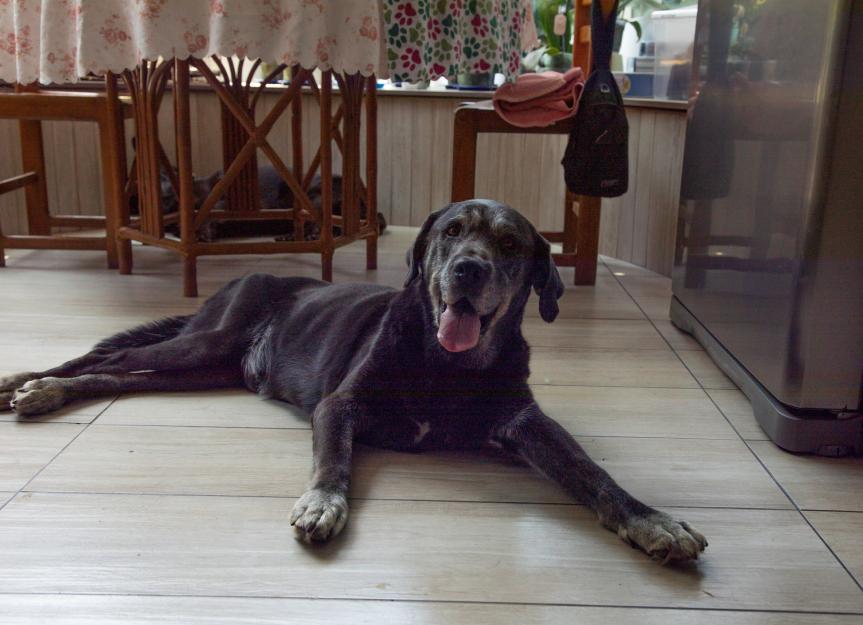
It’s common for pet parents to see their senior dogs become thinner as they age. While this may seem concerning, it’s actually a normal change that happens when dogs get older.
While most pet parents think that their senior dog’s new appearance is due to weight loss, it’s actually a result of muscle mass loss, or sarcopenia.
Below is everything you need to know about sarcopenia in dogs, and how to manage the condition.
Key Takeaways
- Sarcopenia is the age-related loss of muscle mass in dogs, not caused by an underlying disease.
- Senior dogs with muscle mass loss appear thinner, especially in their back legs.
- Diagnosis of sarcopenia in dogs involves first ruling out other conditions like cancer or kidney disease.
- Sarcopenia in dogs cannot be treated or cured, but it can be managed with a high-protein diet, low-impact exercise, supplements, and supportive mobility aids.
What Is Sarcopenia In Dogs?
Sarcopenia in dogs refers to the progressive loss of lean muscle mass due to aging. It is a medical condition common among seniors, but it is not caused by an underlying health issue.
As dogs age, proteins (which build muscle) are not made as effectively or efficiently. The body continues to break proteins down for normal body processes like digestion, but not enough proteins are made to counteract this. This results in overall protein loss, leading to muscle loss.
What Does Muscle Mass Loss Look Like In Dogs?
Dogs with sarcopenia have an overall thinner appearance. They have decreased muscle mass most noticeably in their hind legs. A dog’s head and face may appear sunken, with their bones prominently showing. Their ribs and spine are generally showing through their skin, but they still have full weight in their front legs. They tend to maintain their muscle mass in their front end, while muscle mass is lost in their back end.
Dogs with sarcopenia may sometimes look like they are starving. However, there are several differences between a starved dog and one with sarcopenia.
A starved dog must break down fats and muscle to use as energy since they are not receiving adequate nutrition. This results in loss of both fat and muscle, which makes them appear to be thin and malnourished. However, dogs with sarcopenia, or muscle atrophy, lose muscle mass simply because they are aging.
Starved dogs generally appear thin throughout their whole bodies with prominent bones in their hips, shoulders, head, and ribs. Dogs with sarcopenia, however, are typically fuller in the front half of the body but lacking in their hind end.
Starved dogs’ bodies return to normal fairly quickly after receiving adequate nutrition. In contrast, dogs with sarcopenia will not regain all of the lost muscle mass even with proper management.
Causes of Sarcopenia in Dogs
Aging is the main cause of sarcopenia in dogs. Lack of activity can also trigger this condition, as muscles are not being exercised enough to maintain their mass.
Several health conditions may also worsen muscle atrophy in dogs, including:
These conditions commonly cause muscle atrophy on their own, so having them along with sarcopenia can greatly enhance overall muscle loss in senior dogs.
How Veterinarians Diagnose Sarcopenia in Dogs
To diagnose sarcopenia, a veterinarian must first rule out other possible causes of your dog’s weight loss, such as cancer or diabetes.
This can be done through a complete physical exam and diagnostic testing, such as blood work or imaging. If all tests are normal and no other health condition can explain your dog’s muscle loss, sarcopenia can be diagnosed.
Management of Sarcopenia in Dogs
Sarcopenia cannot be treated or cured, but it can be managed.
The earlier sarcopenia is diagnosed, the better the chance for additional muscle atrophy to be delayed.
To support and maintain muscle mass, veterinarians recommend dietary changes, such as feeding your dog a high-protein diet.
They may also recommend daily exercise, such as swimming or walking.
Since senior dogs cannot handle as much exercise as they once did, it’s important to pace walks and swims at a pace that works for their health. Your vet can help you determine the best exercise plan, depending on your dog’s overall health.
Supplements, such as omega-3 fatty acids, can also benefit dogs with sarcopenia by supporting healthy muscles. They do this by supporting production of proteins and helping to prevent the breakdown of existing muscle.
Dogs with sarcopenia may have other health issues, such as arthritis or loss of mobility, due to their age. To help them get around and to ease pain, you can chat with your veterinarian about adding the following products to your dog’s care:
-
Anti-inflammatories such as meloxicam reduce inflammation in a dog’s joints, which improves their mobility and ability to exercise to maintain muscle mass.
-
Joint supplements, such as glucosamine and chondroitin, support healthy joints so that dogs are able to exercise, which supports healthy muscles.
Sarcopenia in Dogs FAQs
How can I help my dog if they have sarcopenia?
To help your dog with sarcopenia, vets recommend feeding them a high-quality, high-protein diet to support healthy muscle mass and encourage regular exercise such as swimming or walking.
How do you treat sarcopenia in dogs?
Although Sarcopenia can’t be treated, it can be managed through dietary changes, supplements, and daily exercise. Managing any underlying health conditions that could exacerbate muscle atrophy, such as cancer or diabetes, is also beneficial.
What is the difference between sarcopenia and cachexia?
Sarcopenia is the loss of muscle mass due to aging, whereas cachexia is the loss of muscle due to underlying diseases such as cancer. Sarcopenia only affects the muscle, whereas cachexia can also lead to fat loss. In simple terms, sarcopenia is related to aging, while cachexia is related to a specific underlying disease.
Can a senior dog regain muscle mass?
It is possible for dogs to regain some muscle mass. This may be achieved through supplements, regular exercise, and diet changes.



